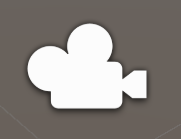Cameras render scenes so that the user can view them. Think about the hidden complexity in that statement. Our games are 3D, but people playing our games view them on 2D displays such as a televisions, computer monitors, or mobile devices. Fortunately for us, Unity makes implementing cameras easy work.
Cameras are GameObjects and can be edited using transform tools in the Scene view as well as in the Inspector panel. Every scene must have at least one camera. In fact, when a new scene is created, Unity creates a camera named Main Camera. As you will see later in this chapter, a scene can have multiple cameras.
In the Scene view, cameras are indicated with a white camera silhouette, as shown in the following screenshot:

When we click our Main Camera in the Hierarchy panel, we are provided with a Camera Preview in the Scene view. This gives us a preview of what the camera sees as if it were in game mode. We will change this in Chapter 7, Implementing Our Player Character...



